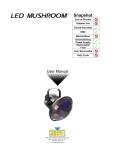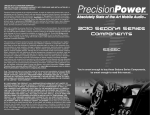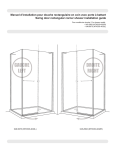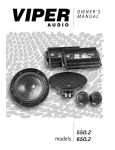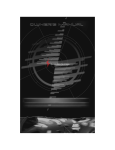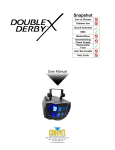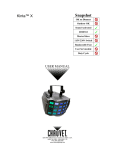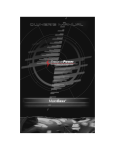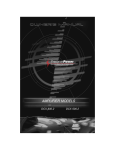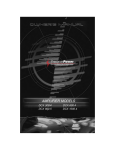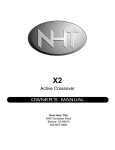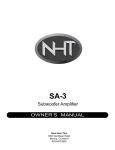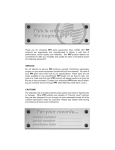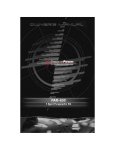Download Directed Electronics G38106 User's Manual
Transcript
PowerClass® COMPONENT SPEAKER SYSTEM INTRODUCTION Thank you for your purchase of this PowerClass® Component Loudspeaker System from PrecisionPower™. Our engineers have combined state of the art materials such as foamed prolypropylene cones and vapor-deposit titanium dome tweeters with cutting edge industrial design to achieve competition-ready performance levels. PRACTICE SAFE SOUND™ Continuous exposure to sound pressure levels over 100dB may cause permanent hearing loss. High power automotive sound systems can generate sound pressure levels in excess of 130dB. When playing your system at high levels, please use hearing protection and prevent long term exposure. Model Number: ___________________ Date of Purchase: ___________________ WHAT’S IN THE BOX Your new PrecisionPower™ PC component speaker kit includes all the necessary mounting hardware and cables for a basic installation: Quantity Description 1 Installation and Operation Manual 2 Titanium Tweeters 2 Tweeter flush mount hardware kits 2 Tweeter surface mount hardware kits 2 Component woofers 2 Passive crossovers 4 Speaker cables (speakers to crossover) 4 Cables (crossover to amplifier) 1 Mounting template 2 Grilles INSTALLATION The performance of your new PrecisionPowerTM Component Loudspeaker system is directly proportional to the quality of installation. Care taken during the installation process will be rewarded with years of satisfying performance. If you are unsure about your installation capabilities, please refer to your local Authorized PrecisionPowerTM Dealer for technical assistance. If you decide to install the speaker system yourself, please read the entire owner’s guide before beginning your installation. 1 TOOLS OF THE TRADE Listed below are tools you may wish to have on hand before starting your installation. Having the proper tools will make the installation much easier. Some of these tools are necessities, some will just make the job easier. • • • • • • • • • Marking Pen Electric Drill 1/4" Drill Bit 1/8" Drill Bit 3/8" Drill Bit Hole Saw Arbor 4¾" Hole Saw (5¼” woofer install.) 5¾" Hole Saw (6½" woofer install.) 1¾" Hole Saw (for flush mount tweeter • Phillips Screwdriver • Volt/Ohm Meter (Optional) • Assorted Tin Snips • Wire Cutters • Wire Crimpers • Wire Strippers • Razor Knife (Optional) install.) FINDING SPEAKER MOUNTING LOCATIONS Choosing the correct speaker locations can have a significant effect on the sound quality of the system. There are many different considerations for choosing the locations that best suit your needs. The locations must be large enough for the speakers to fit without interfering with other vehicle parts such as window mechanisms, etc. Care is needed to ensure that the location you have chosen will not affect any of the mechanical or electrical operations of the vehicle. If minimal intrusion in your vehicle is desired, factory speaker locations may be the ticket for you. Placing the speaker in the factory location can often give you very desirable results. Alternative locations to consider include mounting in customized kick panels, rear decks, or side panels. DOOR MOUNTING When considering possible speaker locations in the doors, be sure to check the operation of the window mechanism and all other moving parts inside the door. Most vehicles use a stabilizer stop bar in between the door and the door jamb. This bar prevents the door from opening too far, but may intrude into the speaker mounting area when the door is closed. Many do-it-yourself installers overlook this and check for speaker clearance only when the door is fully open. 2 REAR DECK MOUNTING In rear deck installations, check the operation of the trunk suspension springs or tension bars. These tension bars can move when opening and closing the trunk and can exert a great deal of force against anything that obstructs their movement, such as a speaker basket or motor assembly. In addition, try to avoid locating the speakers too close to the back edge of the rear deck. Installing the rearmost screws may not be possible without the removal of the rear window. INSTALLING THE MIDRANGE Step 1: Determine where the speaker will be mounted. Make sure there is a flat area large enough for the speaker to fit properly. An uneven mounting surface can damage the driver and limit the bass performance of your PC component system. Step 2: Check to make sure the mounting location you have chosen for the speaker will not interfere with the operation of the vehicle. Step 3: Using the supplied template guide, mark the hole with a pen. Step 4: [Skip this step if using correctly sized factory locations] Cut the hole for the speaker. A hole can be cut either with a pair of metal tin snips, an air or jig saw, or with a hole saw corresponding to the size of the woofer listed below. • 4¾” Hole Saw (5¼” woofer installation) • 5¾” Hole Saw (6½” woofer installation) WARNING: Window mechanisms and electrical wires and other expensive car parts have a nasty habit of hiding where you least expect. CHECK BEFORE YOU DRILL! Step 5: Run the speaker wire to the speakers. Make sure to keep wires away from sharp metal or other edges. When passing through metal, use a protective grommet. 3 Step 6: Using the plastic grille ring as a template, mark the mounting holes with a pen. Step 7: Pre-drill mounting holes using a 1/8" drill bit. WARNING: Window mechanisms and electrical wires and other expensive car parts have a nasty habit of hiding where you least expect. CHECK BEFORE YOU DRILL! Step 8: Pull the wire through the speaker opening and connect to the speaker. Be sure to observe proper midrange polarity during this process. Step 9: To mount the speaker, the speaker is placed through the grille ring from the front. Place the speaker and the grille ring in the installation hole. Align the mounting screw holes and drive in the four mounting screws. Push the perforated metal grille back into the grille ring, using the supplied black butyl material to secure it. GRILL INSERT #8 1-1/4” SHEET METAL SCREWS SPEAKER GRILL RING MOUNTING PANEL 4 NOTE: To remove the trim ring from the tweeter housing: 1. Rotate the trim ring a few degrees in a clockwise direction until you feel a detent. 2. Remove the trim ring by lifting it straight up. INSTALLING THE TWEETER SURFACE MOUNTING Step 1: Determine the tweeter mounting location, then route the wires from the crossover to the tweeter location. Step 2: Place the surface mount housing against the panel and mark the two holes at the rear of the housing. Step 3: Drill the smaller center hole using a 1/8" drill bit. This is the mounting screw hole. Step 4: Drill the larger off-center hole using a 3/8" drill bit, insert a grommet and route the speaker wire from the crossover through the grommet. Step 5: After removing the surface mount tweeter assembly trim ring, route the tweeter wires through the larger hole in the housing and connect to the speaker wires from the crossover. Step 6: Insert the excess speaker wire into the hole and position the housing so the housing will not pinch the wires after final mounting. Step 7: Attach the housing using the supplied screws of the correct length for a solid mount. Step 8: Insert the tweeter into the housing and attach the trim ring. 5 MOUNTING SCREWS SURFACE MOUNT TRIM RING TWEETER SURFACE MOUNT HOUSING PANEL TWEETER WIRE WIRING HARNESS FLUSH MOUNTING INTO REMOVED PANELS Step 1: Determine the tweeter mounting location, then route the wires from the crossover to the tweeter location. Step 2: Mark the center point of the tweeter location. Step 3: If using a hole saw, first drill a pilot hole, then cut out the hole using a standard 2-1/8" hole saw. Step 4: If not using a hole saw, use either the cardboard packaging for the tweeters or the surface mount trim ring as a template to mark the proper size hole. Cut out the hole. Step 5: With the tweeter assembled, route the wires through the hole and the pressure ring and slip the pressure ring over the tweeter assembly. Step 6: Align the tweeter so the logo faces the desired direction then push the pressure ring on to the rear of the tweeter assembly until the tweeter is snugly mounted to the panel. Step 7: Connect the speaker wires observing the correct polarity and re-assemble the panel. 6 TRIM RING FLUSH MOUNT HOUSING TWEETER WIRE WIRING HARNESS FLUSH MOUNTING INTO MOUNTED PANELS Step 1: Determine the tweeter mounting location, then route the wires from the crossover to the tweeter location. Step 2: Mark the center point of the tweeter location. Step 3: If using a hole saw, first drill a pilot hole, then cut out the hole using a standard 2-1/8" hole saw. Step 4: If not using a hole saw, use either the cardboard packaging for the tweeters or the surface mount trim ring as a template to mark the proper size hole. Cut out the hole. Step 5: Remove the tweeter from the flush mount housing and insert the proper length machine bolt through the center hole of the housing and connect to the spring steel Xbracket. (See Figure 3.) Step 6: Connect the speaker wires observing the correct polarity. Step 7: Press the X-bracket portion of the assembly through the hole until its legs spring open. 7 Step 8: Screw the bolts in until the tweeter housing is firmly mounted to the panel. (Make sure the arrow at the rear of the tweeter housing is pointing in the desired direction.) Step 9: Insert the tweeter into the housing and attach trim ring. INSTALLING THE CROSSOVER Step 1: Find a location for the crossover away from any factory or aftermarket electrical wires. It is recommended to mount the passive crossover close to the amplifier. In the event you decide to upgrade and biamplify the system, mounting the passive crossover close to the amplifier would simplify the installation upgrade. Step 2: Remove top cover of crossover housing. Don’t lose it. Step 3: Mark the mounting holes with a marking pen. Step 4: Remove crossover and pre-drill mounting holes using a 1/8” drill bit. WARNING: Window mechanisms, electrical wires, and other expensive car parts have a nasty habit of hiding where you least expect. CHECK BEFORE YOU DRILL! Step 5: Mount the crossover using the supplied #8 screws. Step 6: Connect the wires. Make sure the speaker wires for the midrange go to the woofer output and the tweeter to the tweeter output. Be sure to observe the correct polarity. Changing the polarity of the tweeter may be necessary for optimum sound quality. Use the tweeter level adjustment switch to set the output levels of the tweeters to your liking. Step 7: Re-install the crossover cover. 8 PC PASSIVE CROSSOVER (COVER REMOVED) Woofer To amplifier Tweeter 0 -3 0,-3dB level switch SPECIFICATIONS Model PC 525S PC 650S 4 ohms 4 ohms Power Continuous/Peak 50/100 watts 60/120 watts Frequency Response 90 Hz–20kHz 90 Hz–20kHz 92 db 92 db 2-7/8” 2-15/16” 4-3/4” 5-3/4” 1-3/4” 1-3/4” Nominal Impedance Sensitivity (2.83v @ 1w/1m) Woofer Mounting Depth Woofer Mounting Diameter Tweeter Mounting Diameter 9 Warranty LIMITED TWO YEAR CONSUMER WARRANTY: Directed Electronics, Inc. promises to the original purchaser, to replace this product should it prove to be defective in workmanship or material under normal use, for a period of two years from the date of purchase from the dealer as indicated by the date code marking of the product PROVIDED the product was installed by an authorized Directed dealer. During this two-year period, there will be no charge for this replacement PROVIDED the unit is returned to Directed, shipping pre-paid. If the unit is installed by anyone other than an authorized Directed dealer, the warranty period will be one year from the date of purchase by the dealer as indicated by the date code marking of the product. This warranty is nontransferable and does not apply to any unit that has been modified or used in a manner contrary to its intended purpose, and does not cover damage to the unit caused by installation or removal of the unit. During this one-year period, there will be no charge for this replacement PROVIDED the unit is returned to Directed, shipping pre-paid. This warranty is void if the product has been damaged by accident or unreasonable use, neglect, improper service or other causes not arising out of defects in materials or construction. Units which are found to be damaged by abuse resulting in thermally damaged voice coils are not covered by this warranty but may be replaced at the absolute/sole discretion of Directed. ALL WARRANTIES INCLUDING BUT NOT LIMITED TO EXPRESS WARRANTY, IMPLIED WARRANTY, WARRANTY OF MERCHANTABILITY, FITNESS FOR PARTICULAR PURPOSE, AND WARRANTY OF NON-INFRINGEMENT OF INTELLECTUAL PROPERTY ARE EXPRESSLY EXCLUDED TO THE MAXIMUM EXTENT ALLOWED BY LAW, AND DIRECTED NEITHER ASSUMES NOR AUTHORIZES ANY PERSON TO ASSUME FOR IT ANY LIABILITY IN CONNECTION WITH THE SALE OF THE PRODUCT. DIRECTED HAS ABSOLUTELY NO LIABILITY FOR ANY AND ALL ACTS OF THIRD PARTIES INCLUDING ITS AUTHORIZED DEALERS OR INSTALLERS. Unit must be returned to Directed, postage pre-paid, with bill of sale or other dated proof of purchase bearing the following information: consumer's name, telephone number, and address, authorized dealer's name and address, and product description. Note: This warranty does not cover labor costs for the removal and reinstallation of the unit. IN ORDER FOR THIS WARRANTY TO BE VALID, YOUR UNIT MUST BE SHIPPED WITH PROOF OF INSTALLATION BY AN AUTHORIZED DIRECTED DEALER. ALL UNITS RECEIVED BY DIRECTED FOR WARRANTY REPAIR WITHOUT PROOF OF DIRECTED DEALER INSTALLATION WILL BE COVERED BY THE LIMITED 1 YEAR PARTS AND LABOR WARRANTY. Note: This warranty does not cover labor costs for the removal and reinstallation of the unit. BY PURCHASING THIS PRODUCT, THE CONSUMER AGREES AND CONSENTS THAT ALL DISPUTES BETWEEN THE CONSUMER AND DIRECTED SHALL BE RESOLVED IN ACCORDANCE WITH CALIFORNIA LAWS IN SAN DIEGO COUNTY, CALIFORNIA. © 2003 Directed Electronics, Inc. All rights reserved. G38106/11 12-03











